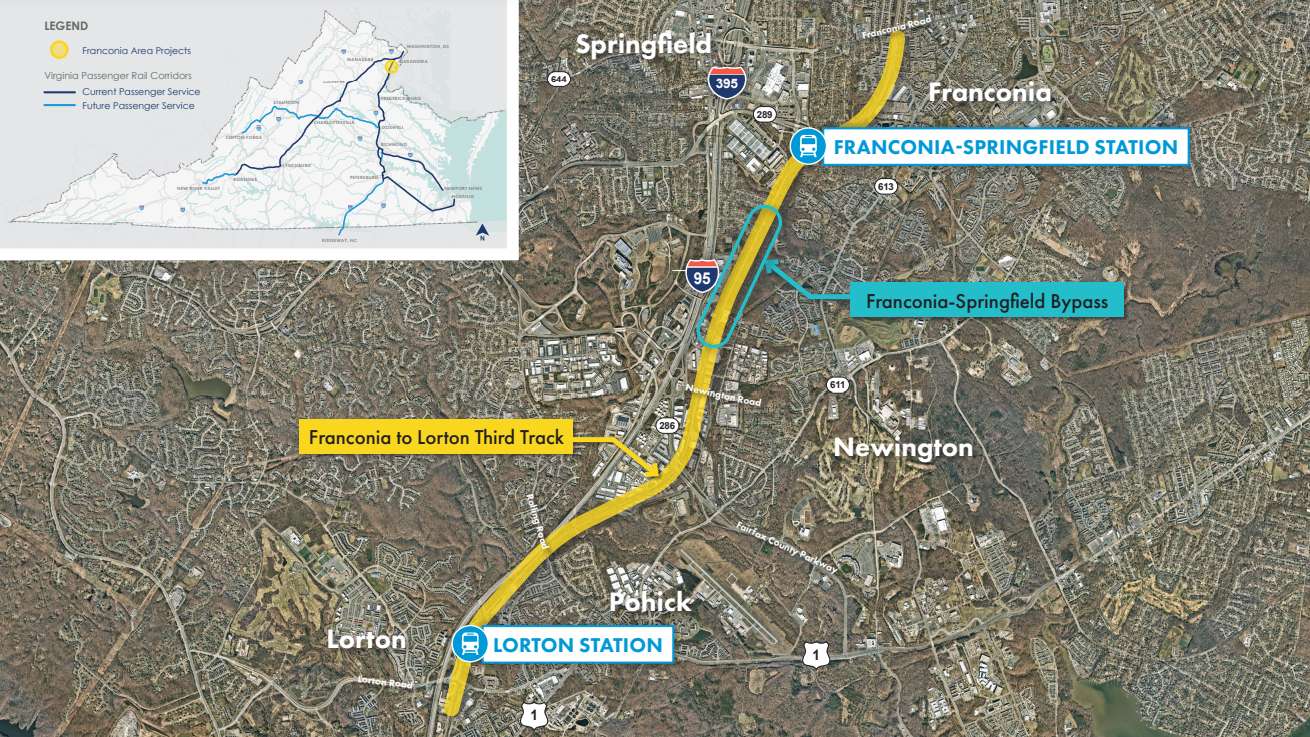
(Updated at 6 p.m.) A project to enhance the capacity of a key rail line through Fairfax County is chugging along, thanks to a major infusion of federal cash.
The Virginia Passenger Rail Authority has been awarded $100 million in federal funds to design and build a bridge that will allow Virginia Railway Express and Amtrak trains to cross over tracks approaching the Franconia-Springfield station (6880 Frontier Drive), Sens. Tim Kaine and Mark Warner announced yesterday (Thursday).
The bridge will relieve congestion and open up the possibility of additional passenger and freight service on the railway, which is one of Virginia’s busiest, according to the senators.
“Passenger rail is a vital connector for so many Virginians — carrying people to their work, their families, and their travel plans,” Warner and Kaine said in a joint statement. “We’re thrilled to see this funding make rail safer and more efficient for Virginians by addressing a critical chokepoint in a vital location, alleviating congestion for hundreds of Virginians every single day.”
Under development since 2021, the Franconia-Springfield Bypass will consist of a roughly 1-mile-long bridge that will carry passenger trains over two existing tracks for CSX freight trains just south of the rail station, VPRA officials said at a neighborhood meeting in July.
The bridge will have just one track, but it will be built to accommodate a future second track.
The project is part of a larger push by Virginia to improve its rail service between Fredericksburg and D.C. Other projects include an extension of a third track that currently starts in Alexandria for about six miles from Franconia to Lorton.
“Expanding passenger rail as an alternative to interstate travel is critical as traffic congestion in Northern Virginia continues to grow at an unsustainable rate,” VPRA Executive Director DJ Stadtler said. “Building the Franconia-Springfield Bypass will allow us to expand our state-supported rail service by alleviating train interference at the most congested point in Virginia…The bypass is key to providing Virginians with reliable, consistent, and convenient passenger rail service.”
According to VPRA, engineering on the bypass is scheduled to begin this year, with construction potentially kicking off in 2024 and finishing in 2026. VPRA has budgeted $405 million overall for the project, a spokesperson says.
The new federal funding comes from the Bipartisan Infrastructure Investment and Jobs Act that President Joe Biden signed into law on Nov. 15, 2021 and a fiscal year 2022 spending package, Warner’s office said.
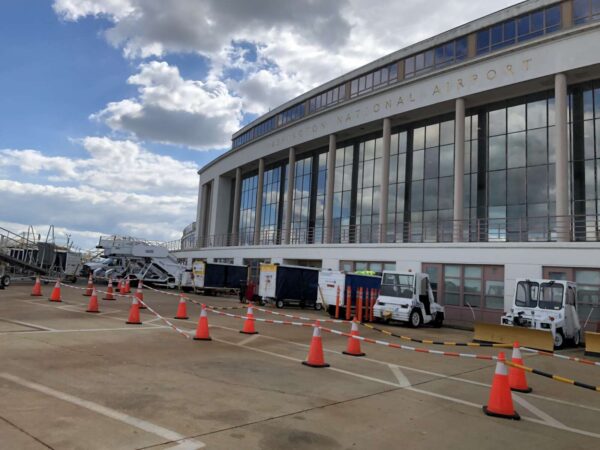
A proposal to add long-distance flights at Reagan National Airport has officially failed, to the relief of area representatives who feared it would undermine Dulles International Airport.
The House of Representatives rejected the proposal — which was included in a package of changes to the Federal Aviation Administration’s policies that passed overall — by a 229-205 vote on Wednesday (July 19).
Pitched by Rep. Burgess Owens (R-Utah), the proposal, which would have increased the number of flights that travel beyond 1,250 miles from National Airport, attracted significant pushback from local and regional officials.
In late May, the Fairfax County Board of Supervisors said the move would increase flight delays and have a detrimental impact on the local economy, arguing that the Arlington airport lacks the capacity of Dulles Airport just over the Loudoun County border.
The legislation pushed by the Capital Access Alliance, a coalition of business groups, continues a long-running battle over slot and perimeter rules originally enacted in the 1960s.
Rep. Don Beyer (D) called the defeat of the proposal a win for the region.
“This strong bipartisan vote of opposition should make it clear, as the Senate takes up their own FAA authorization, that proposals to weaken DCA’s slot and perimeter rules do not have majority support in the Congress,” Beyer wrote in a statement.
Fairfax County Board Chairman Jeff McKay lauded the county’s congressional delegation for defeating the proposal.
“It’s clear that this would have been an intrusive and unwelcome addition to DCA and appreciate the bipartisan approach to supporting residents of Fairfax County,” McKay said.
The Board of Supervisors had argued that the proposed changes would disrupt the balance between the region’s two major airports.
Sen. Mark Warner said he was happy to see “sanity win” in the House.
“I’ll continue fighting these changes — which would exacerbate delays and ruin folks’ travel plans — as we consider this legislation in the Senate soon, too,” Warner tweeted.
Glad to see sanity win in the House last night as they defeated chaotic changes to slot rules at DCA! I’ll continue fighting these changes – which would exacerbate delays and ruin folks’ travel plans – as we consider this legislation in the Senate soon, too.
— Mark Warner (@MarkWarner) July 20, 2023
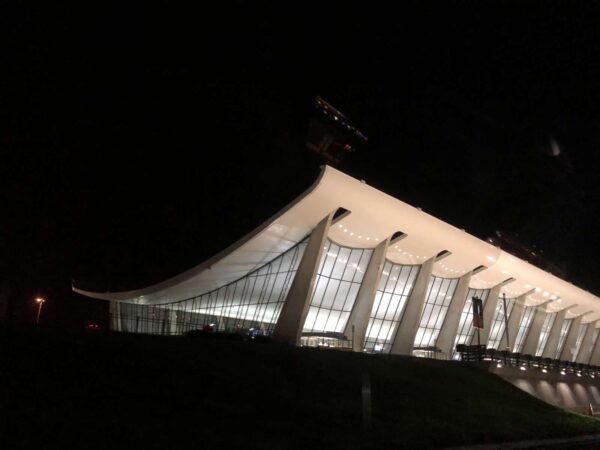
More local legislators are pushing back against a federal proposal to allow more long-distance flights at National Airport (DCA).
The Fairfax County Board of Supervisors voted unanimously yesterday (Tuesday) to oppose the push to increase the number of flights that travel beyond 1,250 miles from the airport in Arlington.
In a letter to the U.S. Senate Committee on Commerce, Science & Transportation, the board argued that the effort would undermine Dulles International Airport (IAD), resulting in “detrimental” impacts on the local economy.
The legislation pushed by the Capital Access Alliance, a coalition of business groups, continues a long-running battle over slot and perimeter rules originally enacted in the 1960s.
The board argues that changes would disrupt the balance between the region’s two major airports and compromise the operating environment for air traffic. The letter also says flight paths for arrivals and departures to the south of DCA have caused major noise issues over residential areas in the county following the implementation of a federal Next Generation Air Transportation System, also known as NextGen.
Board Chairman Jeff McKay emphasized that the issue resolves around public safety. He said that many airline pilots that fly out of DCA say that is one of the “most dangerous” airports to fly in and out of because its designed for specifically-sized airports in the landing area.
“This is not just wrong to impose these changes without a lot of public input, it’s not just wrong for parochial reasons, but it’s wrong to do it in the name of public safety as well, and I think that’s one of the things that’s important for us to emphasize,” McKay said.
Proposing to allow 28 more long-distance flights out of DCA, the bill was introduced on May 10 by Reps. Burgess Owens and Hank Johnson, who represent Utah and Georgia, respectively. It has already faced opposition from Virginia’s senators, a community group looking at the airport’s noise issues, and the Metropolitan Washington Airports Authority, which manages both DCA and IAD.
Congress is expected to consider the proposal this fall.
Mount Vernon District Supervisor Dan Storck and Mason District Supervisor Penny Gross said the issue of airport noise is particularly problematic.
“Mason District is not on a direct path of the airplanes for National, but we are getting increasing numbers of complaints about airplane noise and helicopter noise. So, I’m glad that we’re stepping up and doing this,” Gross said.
Storck said he hopes other efforts can be undertaken to tackle airplane noise, especially in his district. He noted that County Executive Bryan Hill is working with Alexandria and Arlington officials to enlist a consultant that will study ways to mitigate noise impacts.
The county says that maintaining existing perimeter and slot rules is necessary in order to spur growth at Dulles, which is supported by the arrival of Metro’s $6 billion Silver Line extension.
“The interconnectedness of Virgnia’s and the mid-Atlantic’s aviation system makes the continued success of both airports vital to both the Commonwealth of Virginia and the Washington Metropolitan Region,” the letter states. “As such, we request your support in preventing further efforts to modify the perimeter and slot rules to protect the balance between the capacities of our region’s airports.”

A proposal for more long-distance flights at Reagan National Airport (DCA) is catching the ire of some of Virginia’s Congressional representatives, who say it could undermine efforts to grow Dulles International Airport (IAD).
Proponents led by Capital Access Alliance argue that current restrictions at Reagan National — an airport owned by the federal government — are outdated and hurt the economy. They want to increase the number of flights that travel beyond 1,250 miles from the airport, allowing as many as 25 daily round trips.
According to the Alliance:
Since the late 1960s, Ronald Reagan Washington National Airport (DCA) has been the only airport subject to a federally imposed perimeter rule, which limits the number of flights that are allowed to take-off and land outside a 1,250-mile perimeter. However, the consumer, economic, technological and industry landscape has changed substantially in the last 60 years, and the rule’s original goals no longer apply to today’s air travel ecosystem in the nation’s capital.
The group released a study by Boston Consulting Group that argues more long-distance flights would boost all airlines equally, reduce ticket prices for passengers, and result in millions of dollars in economic growth.
But senators who represent Virginia and Maryland say that the proposal will undermine Dulles, just as more customers may utilize the airport due to the arrival of Metro last year.
In a joint statement issued last Wednesday (April 26), Sens. Mark Warner and Tim Kaine said that past efforts to allow exceptions to the perimeter pool have “produced significant stress” on the airport.
“Those changes have also prevented Dulles, whose size allows for larger planes to land and take off, from realizing its full potential as the primary long-haul flight destination for the Washington metropolitan area,” the statement reads.
According to the letter, Reagan National is now seeing more travelers than Dulles, even though the international airport was designed for more capacity.
For over a decade, traffic at DCA has risen sharply, while IAD has declined or stagnated in the same measures. In 2010, total annual enplanements at IAD exceeded those at DCA by more than 5 million. At the end of 2019, before COVID-19 upended the national aviation industry, IAD outpaced DCA by less than a million passengers annually. Now, as we begin to emerge from the pandemic and Americans return to travel, this pattern has worsened. Today, IAD trails DCA by more than 1 million.
The senators go on to argue that loosening the slot and perimeter rules threatened the balance between the airports.
“As Congress prepares to reauthorize the Federal Aviation Administration (FAA), we will strongly oppose any efforts to disrupt or undermine the balance between Dulles and National, an airport one-fourteenth the size of Dulles,” the statement said.
Warner wrote a similar letter to the U.S. Senate Committee on Commerce Science and Transportation in March.
Congress is expected to take up the FAA’s reauthorization bill this fall.

An app created by a trio of Thomas Jefferson High School for Science and Technology students to help kids with autism may someday be deployed in Fairfax County’s special education classrooms.
Sophomores Soham Jain, Rohan Kotla and Samvrit Rao have already earned recognition from Rep. Jennifer Wexton (D-10) for RoutineRemind, an app designed to help parents and kids keep track of their schedules.
RoutineRemind was the 10th District’s winner in the 2022 Congressional App Challenge, Wexton announced on Dec. 22. The annual competition aims to encourage science, technology, engineering and math education by inviting students from across the country to develop and submit their own apps.
The 2022 contest drew over 500 submissions, a new record, according to organizers.
“I was so impressed by not only their remarkable technical skills in designing this winning app, but also their ingenuity and care in developing a way to help kids with autism and their families,” Wexton said in a statement, congratulating the TJ students.
A big congratulations to #VA10's Congressional App Challenge winners, team RoutineRemind—Rohan, Samvrit, & Soham!
I was so impressed by their creation of a scheduling app to aid kids with social and cognitive impairments like autism.
Bravo, RoutineRemind! You've made us proud. pic.twitter.com/Q6stdx5rQ2
— Rep. Jennifer Wexton (@RepWexton) December 22, 2022
In joint comments to FFXnow, Soham, Rohan and Samvit said they have regularly worked together on school projects and share an interest in “the intersection between computer science and biology.”
Seeing the challenge as an opportunity to put their tech and teamwork skills to the test, the students turned to personal experience when brainstorming ideas for an app.
In a demonstration video, Rohan said he has a younger brother with autism and has always been interested in finding ways to improve the lives of people with autism and other cognitive disabilities.
His brother sometimes struggles to remember his schedule, leading him to frequently ask for reminders. Individuals with autism often find comfort in routine, but many also experience executive functioning challenges, affecting their ability to plan or focus.
“After surveying the special needs community in [our] area, we found that this is a mutual problem across children with autism, since many of them are schedule-oriented,” the students told FFXnow. “Given the prevalence of the problem, we wanted to develop a simple, adaptable, and user-friendly schedule and reminder app to help those with social and cognitive impairments.” Read More
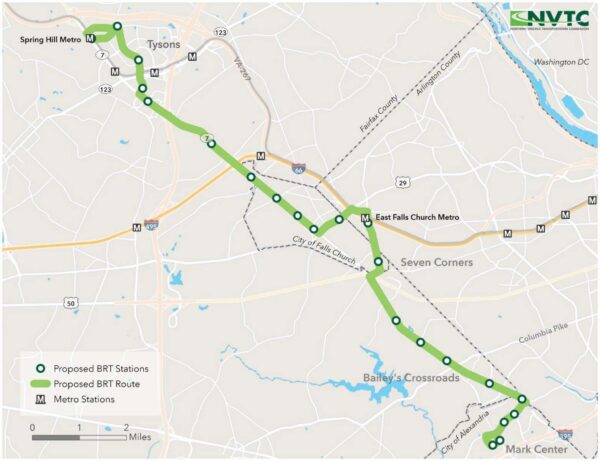
(Updated at 4:25 p.m. on 1/3/2023) An ongoing study of the possibility of having bus rapid transit (BRT) service from Tysons to Alexandria can now proceed confident that the planning will be seen through to completion.
The $1.7 trillion federal spending bill that Congress approved on Friday (Dec. 23), just in time to avert a potential government shutdown, included $2 million to complete all planning and environmental studies needed for the project, known as Envision Route 7.
The Northern Virginia Transportation Commission — the recipient of the funds — has been studying whether and how to bring dedicated bus service to Route 7 between the Spring Hill Metro station in Tysons and the Mark Center in Alexandria since 2013.
The fourth and latest phase of the study — a mobility analysis evaluating the benefits and impacts of BRT — got underway in October 2021. Expected to finish in April, it will be followed by environmental and preliminary engineering design work.
Reps. Gerry Connolly and Don Beyer requested that funds for the project be included in the omnibus bill so it can “complete the planning and National Environmental Policy Act (NEPA) analysis to prepare…for design and construction,” according to a press release from Beyer’s office.
The proposed BRT will provide “high-quality, frequent” bus service along a corridor that’s already the second busiest for buses in Virginia, Connolly said in a separate release:
This BRT project will provide a reliable and affordable transportation option for communities along this corridor; provide a green transportation option that will reduce greenhouse gas emissions and help in the battle against climate change; reduce congestion along a key transportation corridor in Northern Virginia already benefitting from significant economic development and investment; leverage a range of federal, Commonwealth, regional, and local transportation funds; connect major employment centers (U.S. Department of Defense Mark Center, Bailey’s Crossroads, Seven Corners, West Falls Church and Tysons); and further enhance a robust and growing transit system in Northern Virginia.
“The #EnvisionRoute7 BRT will provide as many as 42,000 daily transit trips giving people access to opportunities throughout our region with direct transit connections to Metro at Tysons and East Falls Church, as well as to the new Alexandria West End Transitway,” NVTC said on Twitter, thanking Connolly and Beyer for securing the funds.
The #EnvisionRoute7 BRT will provide as many as 42,000 daily transit trips giving people access to opportunities throughout our region with direct transit connections to Metro at Tysons and East Falls Church, as well as to the new Alexandria West End Transitway.
— NVTC (@NoVaTransit) December 23, 2022
The Tysons segment of the BRT will include six stops, traveling up International Drive and looping around the Spring Hill Metro before taking International back down to Route 7 (Leesburg Pike).
The service will use two transit-only lanes that Fairfax County plans to build by widening Route 7 from Route 123 to the Capital Beltway.
From Tysons, the route continues through Falls Church City, into the Seven Corners and Bailey’s Crossroads area, and down to Alexandria. NVTC held a community meeting to discuss the Falls Church portion in October.
Other Fairfax County projects that got funding from the federal spending package include a cycle track on Sunrise Valley Drive to the Innovation Center Metro station, pedestrian and bicycle upgrades near the Vienna Metro station, and a renovation of the Little River Glen Senior Center near Fairfax City.
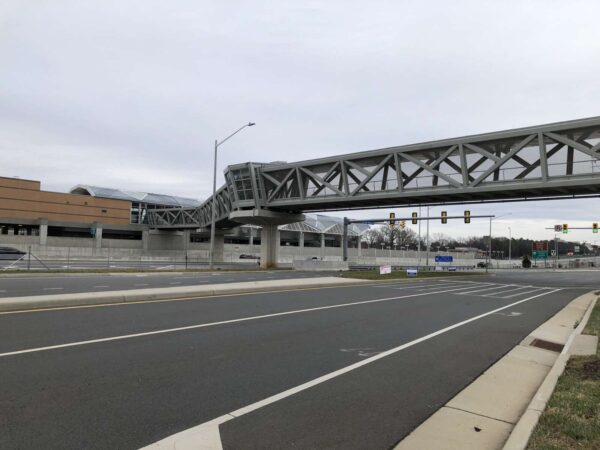
A cycle path to the Innovation Center Metro station is circling closer to construction.
Roughly $4 million in federal funding was secured for the project, which will include a cycle path from Sunrise Valley Drive to Innovation Metro Station, Sens. Mark Warner and Tim Kaine announced yesterday.
Funds were designated in the fiscal year 2023 appropriations bill, a $1.7 trillion spending package that must be adopted by midnight tomorrow (Friday) to avoid a partial federal goverment shutdown.
The upgrades are part of the county’s Active Transportation Program, which covers non-motorized methods of travel and aims to reduce vehicle traffic.
The changes to the four-lane boulevard, which also has additional turning lanes at various intersections, would connect to existing bicycle and pedestrian paths, notably the Fairfax County Parkway Trail, FFXnow previously reported.
“This project will provide significantly improved access to several Washington Metropolitan Area Transit Authority (WMATA) Metrorail Stations and high-density transit-oriented development near the Metrorail Stations and activity centers,” said a statement breaking down the funds designated for Northern Virginia.
Other projects also fit the bill in Fairfax County.
Among them is a neighborhood job and entrepreneurship research center for teens and young adults in the county’s community centers. The centers will offer teens and young adults career readiness skills, job training and leadership programs, according to the release. That project is expected to cost $2.1 million.
In Springfield, the Northern Virginia Community College’s Medical Education Campus will receive $2.2 million to grow its nursing program. Funds will also go towards buying computerized manikins and other technology to supplement clinic training for nursing, respiratory therapy and EMS students.
Other cyclist-related improvements include $1 million for bicycle and pedestrians upgrades near the Vienna Metrorail Station in Oakton. The project is targeted to the area near the station and Oakton High School.
A complete list of secured funds is available online.
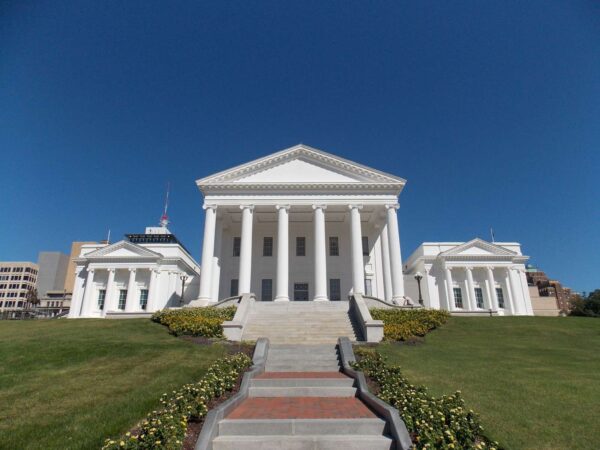
Fairfax County is seeking more state support for education, a return of $39 million for regional transportation projects and more in its recently approved legislative priorities for next year.
At a meeting last week, the Board of Supervisors approved the adoption of the county’s 2023 legislative programs for both state and federal lawmakers. It passed by a 9-1 vote with only Springfield District Supervisor Pat Herrity opposing.
The approval on Dec. 6 was, more or less, a formality with most of the discussion and debate happening in legislative committee meetings throughout the fall.
In addition to trash collection changes, here are a few of the most notable priorities in this year’s agenda:
Increase state support for education
Jointly with Fairfax County Public Schools, the county wants the state to better address the differences between “high cost-of-living jurisdictions like Fairfax County” and other Virginia localities when funding public education.
State education funding is based on complex formulas and varies from year to year. The county has long argued that the formulas don’t adequately account for its higher cost of living compared to other areas.
“Public education funding in the Commonwealth is enshrined in the Virginia Constitution as a joint responsibility of both state and local governments, so it is essential that the state fully and appropriately meet its Constitutional responsibility to adequately fund K-12 education,” the state legislative program says.
Also, both boards oppose “budget cuts that disproportionately target or affect Northern Virginia” and “policies which divert K-12 education funding away from local public schools and toward non-public options.”
Allow traffic safety measures
Local elected county officials have maintained their call for more local authority from Virginia, where localities only have the powers explicitly granted them by the state.
As crash fatalities mount, the county is advocating for General Assembly legislation that lets localities create and post signage requiring motorists to stop for pedestrians in crosswalks.
Legislation is also needed to clarify that counties can reduce speed limits below 25 miles per hour on state-maintained roads that lie in residential districts, according to the program. Without that authority, the county’s options for addressing speeding are limited.
Restore regional transportation project funding
The state diverted $102 million away from the Northern Virginia Transportation Authority (NVTA) in 2018 to the Washington Metropolitan Area Transit Authority (WMATA) to cover Virginia’s share of Metro funding.
In the several years since, $63.5 million has been restored, but the NVTA is still looking for the remaining nearly $39 million to support road repairs, facility maintenance, and other transportation projects in Northern Virginia.
“This [money] will ensure that transportation projects continue to advance in Northern Virginia after decades of state underfunding,” Braddock District Supervisor James Walkinshaw, who chairs the board’s legislative committee, said in his motion at the Dec. 6 meeting. Read More
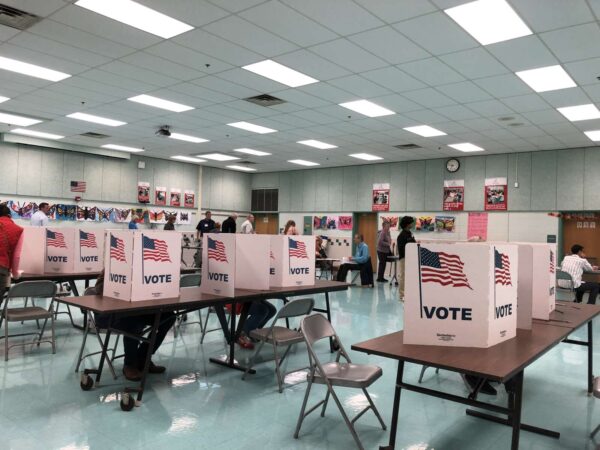
(Updated, 3:35 p.m.) With most incumbents running away to victory, it appears that Fairfax County’s voter turnout for the general election this year will fall short of the 2018 midterms.
About 53% of registered, active county voters took part in this year’s midterm elections, per Fairfax County election officials. That’s about 16 percentage points off from the midterms four years ago. It’s also lower than last year’s gubernatorial election, which had a 60% turnout.
In total, 391,361 ballots have been counted so far in Fairfax County, election officials said.
Turnout numbers remain unofficial. Ballots put into drop boxes will be counted today, while additional mail ballots can continue to arrive until noon Monday (Nov. 14).
Absentee mail and in-person voting rose this election cycle compared to 2018, with 130,350 residents voting early this year — just under 18% of active, registered voters in the county. That’s about 44,000 more people than in 2018, when 12% of voters made their decisions early.
Last year, 174,641 county residents, or about 24% of voters, cast ballots by mail or early in person.
With Fairfax County staying reliably blue, the lack of competitive Congressional races on the ballot may have contributed to the lower turnout compared to other recent elections. Based on the preliminary results, all but one local incumbent — Herndon Town Councilmember Signe Friedrichs — appears to have held their job.
Don Beyer (D) secured victory in Virginia’s 8th Congressional District with 73% of the vote with most precincts reporting. The district includes about 282,000 residents of Fairfax County, where Beyer secured 69% of the vote — about three percentage points lower than what he got in 2020 and 2018.
The re-elected Congressman tweeted out a statement just before 9 p.m. last night, thanking voters for “again putting their confidence in me.”
Grateful to voters in Northern Virginia for again putting their confidence in me to represent them in the House of Representatives. Their trust in me is humbling, and I will continue to do all I can to earn it. My statement: pic.twitter.com/mJCE2SNk03
— Don Beyer (@DonBeyerVA) November 9, 2022
In the 11th Congressional District, Gerry Connolly (D) won his eighth term in office with 66% of the vote overall, with all but two precincts reporting.
The 11th District is almost entirely in Fairfax County, covering about 585,000 residents. That includes Lorton, Burke, Fairfax, Chantilly, Vienna, Tysons, Reston, and most of Springfield and Herndon.
Like Beyer, Connolly didn’t fare quite as well this year in Fairfax County as he did in 2020 and 2018, with 66% of the vote compared to over 70% in both of those election cycles.
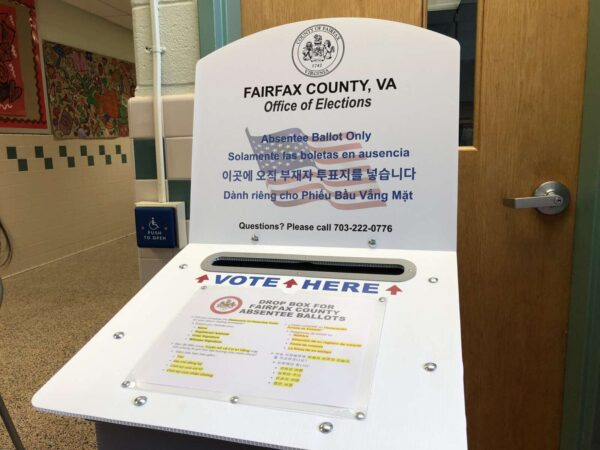
Mayor Sheila Olem will get a second term as mayor of the Town of Herndon after securing a narrow win against council members Sean Regan and Jasbinder Singh in today’s primary election.
According to unofficial results, Olem edged out the race by a little over two percentage points over Regan. Singh received the least number of votes: 16%.
The Herndon Town Council race — which included nine candidates running for six open seats — is extremely close, as is typical in the town’s council elections.
Current members Naila Alam, Cesar del Aguila, and Pradip Dhakal retained their seats, while challengers Clark Hedrick, Keven LeBlanc Jr, and Donielle Scherff secured enough votes to beat out Councilmember Signe Friedrichs.
The following is a breakdown of unofficial election returns for the council race:
- Clark Hedrick: 3,372
- Pradip Dhakal: 3,334
- Keven LeBlanc Jr: 3,164
- Cesar del Aguila: 3,109
- Naila Alam: 3,084
- Donielle Scherff: 2,965
- Stevan Porter: 2,871
- Roland Taylor: 2,692
- Signe Friedrichs: 2,685
It’s not unusual for the outcome of town council races to change once official results are tabulated.
In 2020, for example, a data entry error dramatically changed the results of the mayoral election.
In this year’s midterm elections, Democratic incumbents representing portions of Fairfax County once again maintained a stronghold over their seats in the House of Representatives.
Democratic incumbents Don Beyer (D-8) and Gerry Connolly (D-11) clenched a decidedly confident victory over their Republican challengers: Karina Lipsman, Hung Cao and Jim Myles, according to uncertified election results.
But Jennifer Wexton’s (D-10) win over challenger Cao was significantly closer than her Democratic colleagues.
The incumbent had a 6-point-percentage margin, with 90% of precincts reporting, as of 10:20 p.m.
In Fairfax County, she led by a mere 48 votes, according to Fairfax County’s unofficial returns.
Victories for Beyer and Connolly were far less contentious, with Beyer winning over 75% of votes versus Lipsman’s nearly 23% and Connolly winning 68% over Myles’s 31%.
Beyer said that he was grateful for voters’ confidence in his ability to represent them.
“I will continue to do all I can to earn their trust, and to serve my constituents,” he wrote in a statement today.
Grateful to voters in Northern Virginia for again putting their confidence in me to represent them in the House of Representatives. Their trust in me is humbling, and I will continue to do all I can to earn it. My statement: pic.twitter.com/mJCE2SNk03
— Don Beyer (@DonBeyerVA) November 9, 2022
Fairfax County hit a 45% turnout rate for the midterms, as of 3:50 p.m., but that number does not account for three hours of voting that remained at the time.
Still, the number appears shy of 2018 midterms when 59.5% of registered voters cast a ballot. In 2014, a mere 41.6% of registered voters voted.

